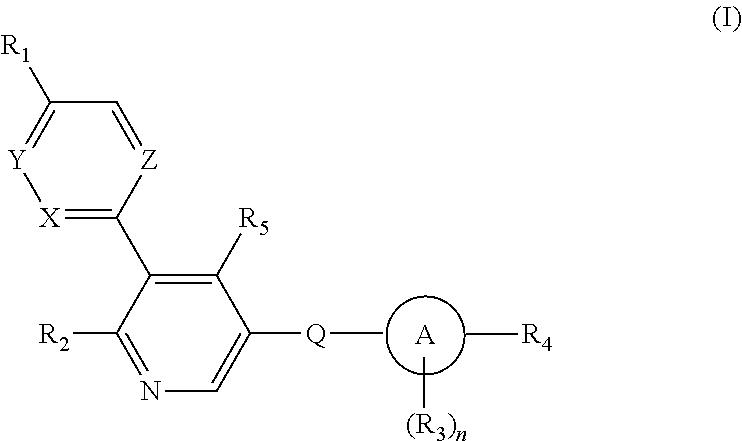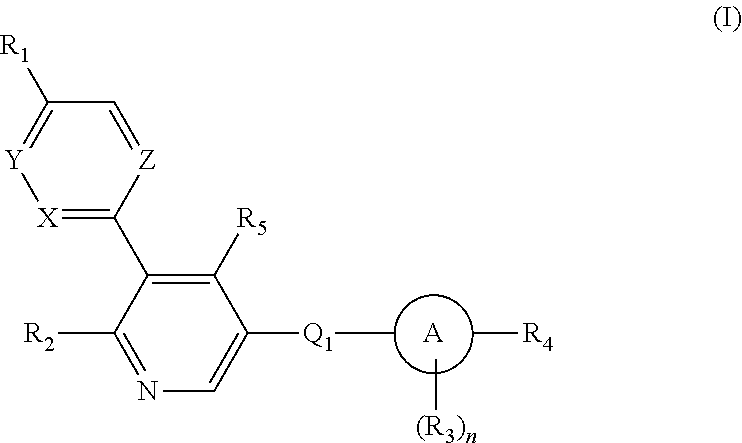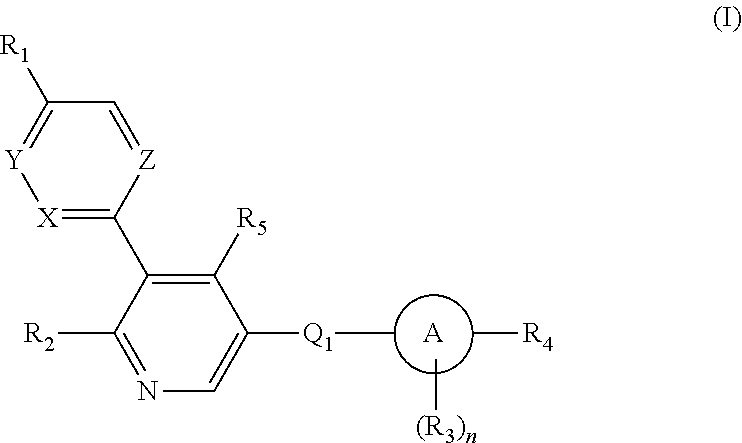Aryl-bipyridine amine derivatives as phosphatidylinositol phosphate kinase inhibitors
a technology of aryl-bipyridine and amine, which is applied in the direction of group 3/13 element organic compounds, immunological disorders, drug compositions, etc., can solve the problems of no known therapeutic agents which effectively inhibit the synthesis of pip5kii-beta, and achieve the effect of improving the efficacy and safety profil
- Summary
- Abstract
- Description
- Claims
- Application Information
AI Technical Summary
Benefits of technology
Problems solved by technology
Method used
Image
Examples
example 1
bipyridin]-5-yl)-N,N-dimethylbenzamide
[0865]
[0866]To a mixture of 3,5-dibromopyridine (200 mg, 0.84 mmol), 4-pyridylboronic acid (52 mg, 0.42 mmol) and K2CO3 (0.47 g, 3.38 mmol) in 1,4-dioxane (3 ml) and water (0.75 ml) under N2 was added Pd(PPh3)4 (49 mg, 0.04 mmol). The resulting mixture was stirred at 70° C. for 3 h, then [4-(dimethylcarbamoyl)phenyl]boronic acid (81 mg, 0.42 mmol) was added and the mixture was stirred at 90° C. for 2 h. More [4-(dimethylcarbamoyl)phenyl]boronic acid (81 mg, 0.42 mmol) and PdCl2(Amphos) (15 mg, 0.02 mmol) were added and stirring continued at 90° C. overnight. When cooled to rt water and EtOAc were added, the organic layer separated and the aqueous layer was extracted with EtOAc. The combined organics were washed with brine, dried over Na2SO4, filtered, concentrated and purified by preparative HPLC to give the product as a solid (18 mg, 7%). 1H NMR (500 MHz, CHLOROFORM-d) δ ppm 3.05 (br s, 3H), 3.15 (br s, 3H), 7.59 (br d, J=7.10 Hz, 2H), 7.64-7.7...
example 2
pyrrolo[2,3-b]pyridin-4-yl)pyridin-3-yl)-N,N-dimethylbenzamide
[0867]
example 3
pyrrolo[2,3-b]pyridin-4-yl)-[3,3′-bipyridin]-5-yl)-N,N-dimethylbenzamide
[0868]
[0869]A mixture of (5-chloro-3-pyridyl)boronic acid (227 mg, 1.44 mmol), 4-chloro-1H-pyrrolo[2,3-b]pyridine (200 mg, 1.31 mmol), K2CO3 (453 mg, 3.28 mmol) and PdCl2(Amphos) (46 mg, 0.07 mmol) in 1,4-dioxane (5 ml) and water (2 ml) was heated in a microwave reactor at 125° C. for 40 min. EtOAc and water were added and the organic layer separated. The aqueous layer was extracted with EtOAc. The combined organics were washed with brine, dried over Na2SO4, filtered, concentrated and recrystallized from 2-propanol to give a mixture of intermediates as a solid (130 mg). The solid was taken up in 1,4-dioxane (5 ml) and water (2 ml), together with [4-(dimethylcarbamoyl)phenyl]boronic acid (120 mg, 0.62 mmol), K2CO3 (196 mg, 1.42 mmol) and PdCl2(Amphos) (20 mg, 0.03 mmol). The resulting mixture was stirred at 95° C. for 2 h. When cooled to rt EtOAc and water were added and the organic layer separated. The aqueous l...
PUM
 Login to View More
Login to View More Abstract
Description
Claims
Application Information
 Login to View More
Login to View More - R&D
- Intellectual Property
- Life Sciences
- Materials
- Tech Scout
- Unparalleled Data Quality
- Higher Quality Content
- 60% Fewer Hallucinations
Browse by: Latest US Patents, China's latest patents, Technical Efficacy Thesaurus, Application Domain, Technology Topic, Popular Technical Reports.
© 2025 PatSnap. All rights reserved.Legal|Privacy policy|Modern Slavery Act Transparency Statement|Sitemap|About US| Contact US: help@patsnap.com



